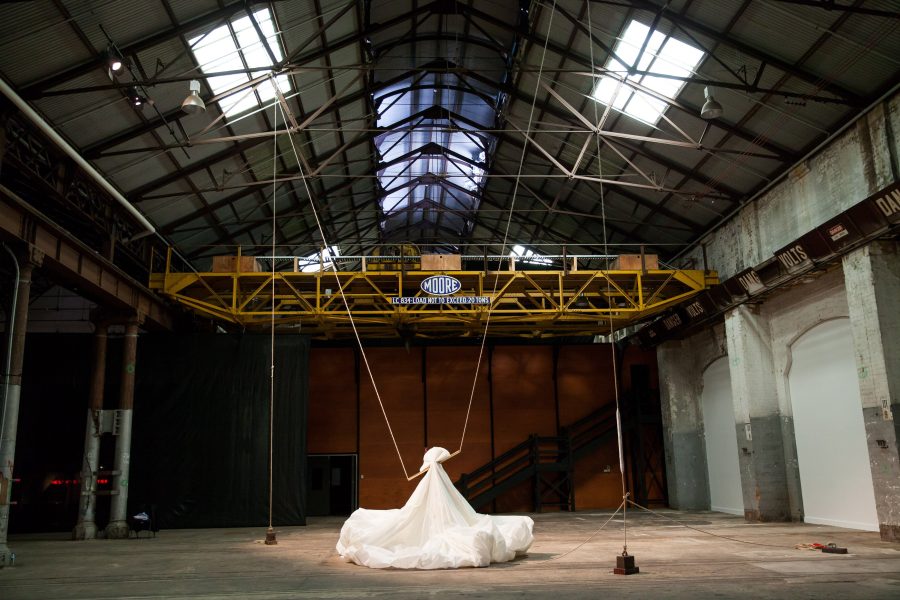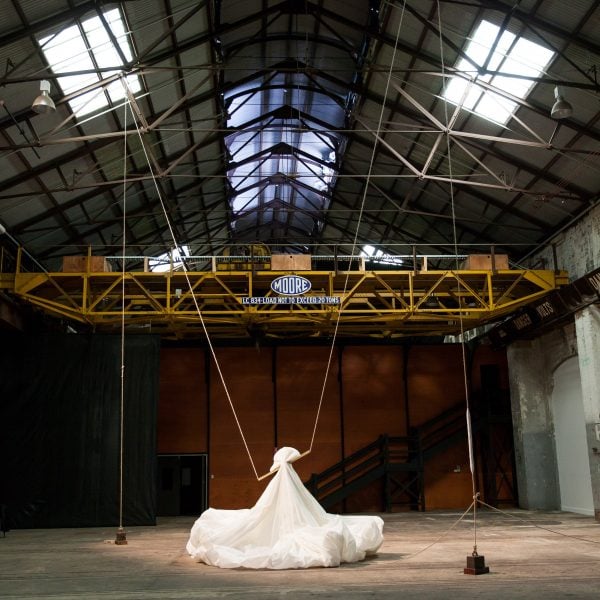Home Participants 20th Biennale of Sydney (2016) Lauren Brincat
Lauren Brincat


Lauren Brincat
Born 1980 in Sydney, Australia Lives and works in Sydney

Drawing inspiration from a range of sources – from durational, body-oriented forms of practice that came to prominence during the 1970s, to Dada and Japan’s Gutai group – Brincat’s action-based works are also often presented as installations or video documentation and sometimes accompanied by a live element.
For the 20th Biennale of Sydney, Brincat has embarked upon an ambitious new body of work, ‘Performance Instruments’, that begins with Salt Lines: Play It As It Sounds, Performance Instruments, 2015–16, a site-specific installation for Carriageworks. Constructed primarily from white sailcloth and incorporating custom-made church bell ropes and finely crafted red woollen hand grips known as ‘sallys’, Salt Lines is a meditation on the geographical borders that exist across the world ocean – the immense and interconnected body of water that covers some 70 per cent of the earth’s surface. Brincat has long been interested in points of intersection and delineation, and in the human experience that results from such divisions.
Responding to the scale of Carriageworks’ large industrial spaces, Salt Lines is some five metres tall and can stretch to a length of 42 metres. Like a concertina, the pleated sailcloth is able to expand and contract, mimicking the continuous redistribution of volume caused by the tidal rhythms of the ocean. Brincat often incorporates the sonic elements of her selected materials into her work. In Salt Lines, the fabric crunches as it moves; and while there is an absence of ship or church bells in the installation, their presence is suggested by the ropes and sallys. Each day over the course of the exhibition a person selected by Brincat is invited to reconfigure the work, adjusting the ropes and pulleys and rearranging the installation. While not considered a performance, this ‘maintenance’ will occur during public hours and will result in Salt Lines taking on a different appearance each day, swelling and creasing at the whim of the aide. Over the duration of the exhibition the fabric will become more malleable, shapeshifting and never appearing in the same state twice.
The crafting of bell ropes was mastered by sailors during the height of sea trade in the eighteenth and nineteenth centuries, a period during which notions of the romantic and the sublime dominated artistic output. Brincat’s own practice taps into these ideas as she investigates a personal relationship to sailing and the sea, probing the dual dynamics of fear and elevation invoked by an encounter with the vastness of nature.
Lauren Brincat has held numerous solo exhibitions of her work, including ‘No Performance Today’ (with Bree van Reyk and the NSW Police Marching Band), ‘Sonic Social’, Museum of Contemporary Art Australia, Sydney (2014); and ‘It’s Not the End of the World’, Anna Schwartz Gallery, Melbourne (2013). Select group exhibitions include ‘PP VT (Performance Presence/Video Time)’, Australian Experimental Art Foundation, Adelaide (2015); and ‘LANDSEASKY’, Media Art Asia Pacific (MAAP), Seoul Museum of Art, Seoul (2014).
Lauren Brincat does not confine herself to prescribed methods of production. While continuing to acknowledge the influence of her formal training in painting, she no longer uses brush or paint, instead working across and between mediums such as installation and video. Brincat is perhaps best known for task-based performances – undertaken anonymously and in relative solitude – that test what the artist has described as her ‘physical and cognitive limits’.